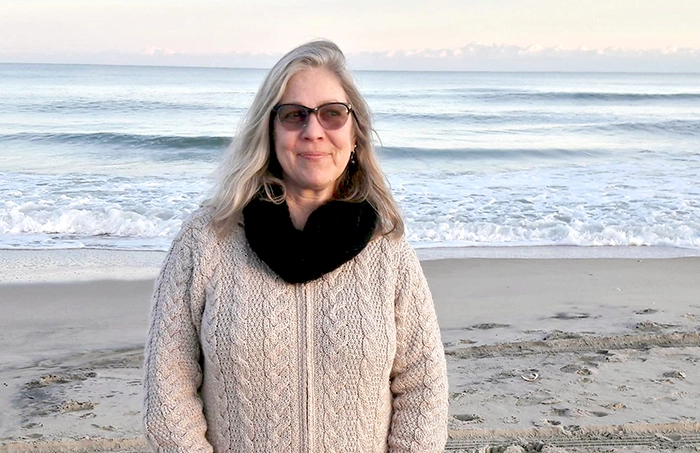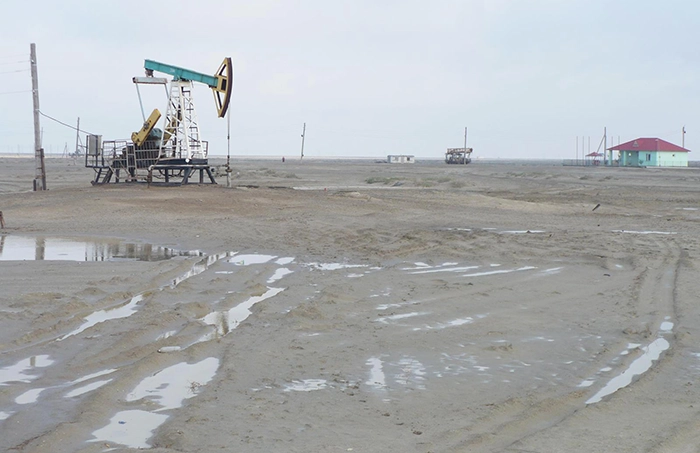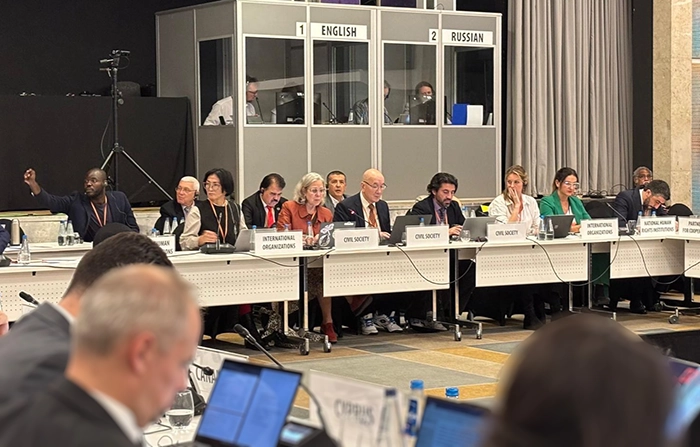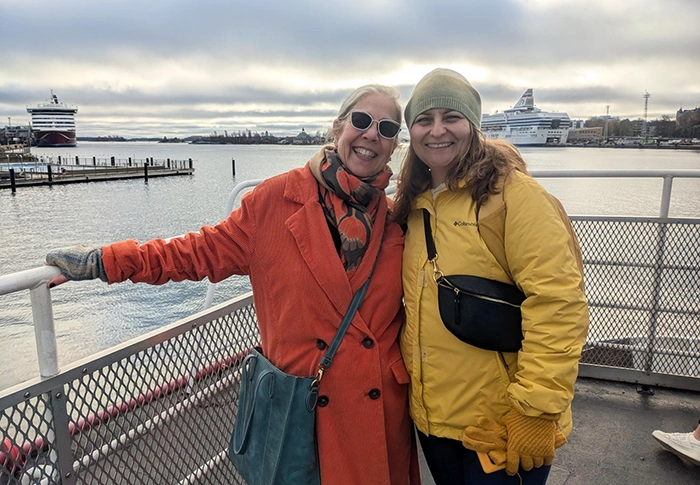Kate Watters is the co-founder of Crude Accountability and has served as its executive director since the organization was founded in 2003. She is also a co-organizer of the international campaign “Prove They Are Alive!”
Crude Accountability began its work in Central Asia, the Caucasus, and Russia in the early 1990s. Initially, in cooperation with local activists, the focus was on environmental issues, later expanding into human rights advocacy.
Kate has traveled extensively throughout the region and is personally acquainted with local scientists, activists, environmentalists, and human rights defenders.
She is the author of numerous reports and articles on civil society in Central Asia and the Caspian region. She holds a master’s degree in Russian Area Studies from Georgetown University and a bachelor’s degree in Russian literature from the University of Massachusetts Amherst.
We met with Kate Watters to talk about her organization’s work, their accomplishments, and plans.

Kate Watters. All photos: personal archive
— Kate, tell us about Crude Accountability. You recently marked 22 years of work. What have been your main projects and achievements?
— Yes, it’s hard to believe, but it’s already been 22 years. When we started, the world was different. Even then, it was clear there was no framework for cooperation between local activists, environmentalists, scientists, and international oil companies operating in the region. And there were many of them. No one knew how to engage with the authorities. There were no coalitions.
Even among NGOs, there was no unity. They didn’t know how to come together, protect themselves, or fight for a shared cause — like defending the region’s environment from the expanding oil and gas sector. How could natural resources be used responsibly?
The Resource Curse
“New fields were being developed not only offshore in the Caspian Sea but also on land — where people lived,” Kate continues. “We started Crude Accountability with local environmentalists to protect communities from the negative impacts of oil companies. To protect nature, simply put.”
— Our first projects were in Kazakhstan, though we also worked in Turkmenistan, Azerbaijan, and Russia. One of our biggest early cases involved relocating the village of Berezovka in Kazakhstan, which was near the Karachaganak oil field. Residents, especially children, suffered from serious health problems — breathing difficulties, skin conditions.
That’s when we, along with local organizations, launched a project to investigate the causes.

“I want to be clear,” Kate says, “we only worked where we were invited. It’s not like we just pointed to a map and decided to save the world,” she laughs. “At that time, the field was operated by a consortium of four major oil companies: Lukoil, Chevron, PG, and ENI. No Kazakh companies. Hard to imagine today. But none of them assessed their environmental impact. Everything we achieved was thanks to local NGOs. We measured hydrogen sulfide levels in the air. We discovered the technology didn’t meet standards. We helped residents file complaints with the World Bank, which funded the project.”
— The result was a successful relocation of Berezovka’s residents to a safer area. Kate emphasizes that the foreign companies paid for the move.
“It was a symbol of their responsibility, even if they never admitted people were harmed by their operations,” she says.
Kate adds that the companies also improved their infrastructure.
“It got cleaner and safer — not perfect, but a lot better. That’s a real result,” she says.
Asked whether there was a similar case in Turkmenistan, Kate replies:
— Turkmenistan was very difficult. We couldn’t get in, couldn’t work there. It was the most closed country. So, we focused on gathering data about foreign companies operating there — those supporting the regime and ignoring massive human rights abuses. That database was the first of its kind.
From Environmentalists to Human Rights Defenders
— You started with environmental issues and then shifted to human rights and civil society. How did that happen — and why is it important?
— That’s a good question, and my answer has two parts.
First: in Turkmenistan, massive foreign investment in energy enriched the regime. No one cared about human rights violations. We wanted to raise awareness — to show these companies that working in such countries means supporting a totalitarian regime.
Second: When we first engaged in Turkmenistan on environmental issues, that was the only window available. Environmental activism wasn’t yet under tight government control.
“At first, they saw our work as harmless — crazy ‘green’ people hugging trees and saving butterflies,” Kate recalls. “But eventually, the government cracked down on us too.”
“For Crude Accountability members, it wasn’t too scary. I could always return to the U.S. But for our local partners, it became dangerous. They were interrogated, threatened, sometimes assaulted. Some were banned from working.”
“Then came the arrests,” Kate says. “We realized we weren’t just environmentalists anymore. We had to become human rights defenders. The risks in Turkmenistan forced us to shift focus.”
— Would it be fair to say that authoritarian regimes pushed you into human rights work? That had they left environmentalists alone, maybe the rights abuses wouldn’t have come to light?
“Exactly,” Kate replies. “There’s no dividing line between environmentalists and human rights activists. We’re all in the same boat. A threat to one of us is a threat to all.”
— What are the biggest challenges of working in closed countries like Turkmenistan?
— The hardest part is ensuring the safety of our partners on the ground. That’s our number one priority. Unfortunately, the risks for civil society actors in Turkmenistan are extremely high. And we, operating from outside, have no reliable way to help them if something happens. That forces us to be very cautious — and caution slows everything down.

Speaking at OSCE Human Dimension Implementation Meeting
Kate notes that in the Soviet era and immediately after the USSR’s collapse, the “rules of the game” were at least somewhat clear. You knew what you could and couldn’t do. There were limits. Now, she says, it’s chaos. “It’s impossible to tell what’s legal and what could suddenly become illegal. There’s a complete disconnect between the law and reality.”
“Almost everything is forbidden. We don’t know what’s allowed anymore — and I believe that’s intentional, to make our work harder,” Watters says.
— Have you ever had any contact or dialogue with the governments of these countries? For example, Turkmenistan has a Ministry of Ecology.
— No, not in Turkmenistan. In the past, we did have some cooperation with Kazakh authorities, and we’re trying to rebuild that now. Also, not with Azerbaijan — they don’t respond at all. It’s a terrible situation for activists there. In Russia, it used to be possible, but not anymore. Looking over the years, I’d say the situation everywhere is just getting worse.
— Have these governments at least tried to create the appearance of dialogue? You’d think it would be in their interest to cooperate on environmental issues.
— Sometimes, yes. But it’s always surface-level and comes with denial of the real problems. And when we cite NGO sources, it becomes a threat — for them. It’s very hard to hold any kind of real conversation under those conditions.
— In the early 2000s, after the alleged assassination attempt on Niyazov, Turkmenistan entered a very dark period. Was it easier to work back then — or now? To engage both NGOs and the state?
Kate pauses for a long time before answering:
— Mmm… I don’t know. That’s a good question, but I don’t know how to answer it. It’s complicated. I can say the threats have changed. But it’s a hard question. No one really knows — everything is just so closed.
Prove They Are Alive!
— Tell us about the “Prove They Are Alive!” campaign. How did the idea come about? Why is it important to talk about political prisoners and enforced disappearances? How hard was it to gather information? And how do you raise this issue with the Turkmen authorities, who refuse to even acknowledge it?
— We know that Turkmenistan has many political prisoners whose fate has been unknown since the day they were arrested. And we want to know — are they alive or not? When we started asking that question, of course, the Turkmen authorities responded, “What are you talking about? We don’t have any disappeared people!”
In the past, they flatly denied everything. Now, their denials are a bit more measured. Turkmenistan does send delegates to international human rights conferences. Their presentations have become more polished. Sometimes they answer questions, sometimes they don’t. And it’s unclear whether they’re hiding something or truly don’t know.

With “Prove They Are Alive!” colleagues Olga Zakharova and Juriy Dzhibladze
— Do you think this could be because the Ministry of Foreign Affairs in Turkmenistan is now staffed by a younger generation — people who weren’t even aware of these events 20 years ago? Maybe they were just kids at the time and don’t carry the same emotional memory as those who lived through the fear and repression? So, they’re simply not interested in what, to them, is just distant history?
— Yes, I think that’s exactly it. They weren’t witnesses to those events. They didn’t live through the era of mass repression. They didn’t receive the same kind of information we did. It’s a different generation. For them, it’s just history — unpleasant, maybe, but still history.
Kate explains that at the beginning of the “Prove They Are Alive!” campaign, they didn’t struggle to gather information. There was already a report by Emmanuel Decaux on political prisoners, and the OSCE’s Moscow Mechanism had already been launched. Human rights organizations had collected enough material, which formed the basis of their work, she says.
After that, they began searching for people — those who might know something or knew someone who might know. According to Kate, it was like a game of “telephone.” Information came in bits and pieces and had to be carefully verified. Some facts were confirmed. Others remain unresolved to this day.
— After we compiled the baseline information, getting anything new became much harder — people were afraid to talk to us. Everything we managed to gather, we submitted to the United Nations. Once the project became more widely known, people started reaching out to us — usually family members, asking us to find out what happened to their loved ones.
The Moscow Mechanism (Human Dimension Mechanism) of the OSCE is the OSCE's method of work in the human dimension. It is based on the principles and provisions of the Helsinki Final Act that one or more OSCE participating States may express an interest in situations and specific cases relating to the human dimension in other OSCE participating States, thereby ensuring greater respect for human rights, fundamental freedoms, democracy and the rule of law through dialogue and co-operation, as well as facilitating the resolution of specific issues related to this area.
On 20 December 2002, 10 OSCE participating States – Germany, the United States, Austria, Canada, the United Kingdom, Greece, Ireland, Italy, Norway and Sweden – invoked the OSCE Moscow Mechanism and appointed an OSCE Rapporteur Mission to gather information about investigation into the alleged assassination attempt on Turkmen President Saparmurat Niyazov on 25 November 2012.
Professor of law Emmanuel Decaux (France) was appointed rapporteur.
“We had to get creative in writing our reports. For example, details about the layout of the Ovadan-Depe prison came from satellite images. I suspect the Turkmen authorities were shocked when we published that,” Kate recalls.
When asked whether they’ve managed to confirm the fate of any of the disappeared prisoners—whether someone is alive or dead — Kate replies:
— Yes, absolutely. We have a whole list of names whose fate has been confirmed. We know that some of the disappeared died in prison. It’s painful to say, but it’s verified information. Some of them have been buried, others haven’t — but we know, with certainty, that they’re dead.
“It’s a gross human rights violation. If someone dies in custody, return their body to the family! We know they’re gone — but where are the bodies?” she says, visibly angered.
— Were you ever able to find out — from anyone — what happens to the bodies of prisoners who die in custody?
— No, that’s something we haven’t been able to uncover.
Another tragic discovery, she says, is a list of over 30 names — people who served their full sentences but were never released. No one knows what happened to them.
Unanswered Questions
“I raised this question at one of the OSCE plenary sessions. It’s a crucial issue: what happened to these people? Where are they?” demands Kate. “I think it’s a very simple task for any foreign diplomat — to just ask the government of Turkmenistan: We know these individuals have served their 10 or 15 years. Where are they? This is a humanitarian issue. Just show them alive!”
— Has your organization asked the Turkmen government this question directly?
— Of course! Many times. But they don’t respond. No answer at all.
— Why isn’t this issue raised more actively by UN or OSCE leaders in Turkmenistan, or by foreign ambassadors?
— I think they do ask. I’m sure they do. But they don’t get an answer either.
— So that’s it? One side asks, the other doesn’t answer — and it’s been like that for over 20 years?
— That’s exactly what’s happening. It’s very sad.
Kate notes that in 2020, the OSCE officially recognized enforced disappearances as a form of torture.
“That wasn’t the case before. And it’s important to understand that torture doesn’t just affect the prisoner — it’s also torture for the family, for the loved ones, for everyone who cares about that person. You can’t mourn them like the dead, because there’s always that ‘what if they’re still alive?’”
She believes this ongoing silence is a grave crime by the Turkmen authorities — and the fact that it continues means the situation in the country is not improving.
“There must be some internal logic behind why they’ve kept silent for so many years — but it’s not something we can understand.”
— You’ve spent a lot of time in Turkmenistan and Central Asia. How would you assess the human rights situation in the region overall? Is there any hope for democratic reform in Central Asia? Which country, in your view, is the closest to achieving that?
— Maybe this sounds naïve, but I believe there is hope for democratic transformation everywhere. I think in every country, there are people who want democracy. What scares me now is that democratic freedoms are being eroded globally — even in the U.S.
“What matters most is how we — as human rights defenders, environmentalists, civil society activists — can come together and push back.”
“Donald Trump’s Goal Is to Create Chaos in the World”
— How do you think current global events — like the war in Ukraine and Donald Trump’s return to power in the U.S. — might affect the situation in Turkmenistan? Does the new White House administration have any interest in countries like Turkmenistan?
— Of course, these events influence democratic development everywhere. I’d say we’re in a global crisis right now. And the Trump administration definitely makes things worse — it impacts everyone.
“There is absolutely no chance that Donald Trump is interested in bringing democracy to Turkmenistan — I’m sure of that,” Kate adds. “But maybe the country’s natural resources will catch his eye,” she jokes.
— Donald Trump recently announced the shutdown of Radio Free Europe/Radio Liberty. What would it mean for Turkmenistan if its Turkmen-language service Azatlyk stops broadcasting?
— Well, first of all, it hasn’t been shut down yet. The case is currently in court, so we’ll see what happens. Radio Free Europe filed a lawsuit against Trump over the unlawful shutdown order. The process of freezing their funding was halted, and a judge ruled that all funds must be returned to the outlet’s accounts.

— How great is it that in America you can sue the president!
— Yes, for now, at least. And that’s encouraging. I’m glad they acted quickly. In the U.S., a president can’t just shut down a media outlet because he feels like it. And Trump knows that. I think one of his goals is simply to create chaos — so that no one understands what’s happening, what’s allowed, what’s not, what’s legal or illegal. That’s why we’re seeing all these drawn-out legal processes and resource-draining battles.
— Can Russian foreign policy influence anything in Central Asia — and Turkmenistan in particular? Is Russia interested in the region?
— Short answer: yes! It’s clear that Putin wants to expand his sphere of influence. Russia’s main competitor in Central Asia is China. I’d say the region is now in an extremely complex geopolitical position — surrounded by large, powerful countries that are competing, and other states that are unstable. Russia will definitely try to maintain its influence. Let’s just hope it doesn’t go the way of Ukraine.